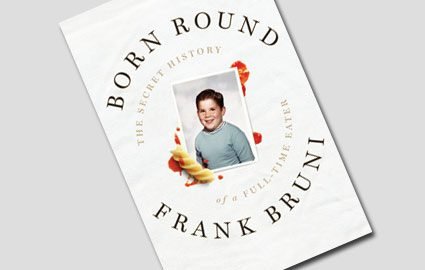Frank Bruni's "Born Round"
Iconic male food writers like A.J. Liebling and R.W. Apple were large men; they flaunted their girth in ways that their female counterparts (M.F.K. Fisher, Elizabeth David, Ruth Reichl) did not. Their weight helped them cultivate an aura of power and authority; it's easy to imagine them sitting in a brown leather chair, patting their tummies after a large meal, smoking a very expensive cigar and sipping a very fine Brandy. But to quote the Monkees: that was then and this is now.
Now, in the 21st century, there's a shift; it's no longer fashionable or as socially acceptable for men (even men in the food world) to be more than a little bit chubby. Restauranteur Joe Bastianich lost so much weight he looks like a different person....
Before:
After:
Ed Levine documented a diet on Serious Eats in which he lost approximately 40 pounds. And now Frank Bruni, a man who spent years eating in some of the world's greatest restaurants, has a memoir (recently out in paperback) that doesn't extoll the luxurious splendor of an Epicurian lifestyle but, instead, focuses on his own struggles with weight.
It's a powerhouse of a memoir; superbly crafted, deeply moving, and also very funny. It traces, step-by-step, how a smart, able kid (the young Frank) goes from doted-upon beneficiary of his Italian mother's and grandmother's food to a pill-popping, bulimic college student to a hyper-ambitious journalist covering the Bush campaign for The New York Times and gaining so much weight his pant size enters the realm of the 40s.
What's so affecting about the work is how he opens up his inner-life so generously; you are inside his head with him as he tortures himself about how he looks, convincing himself that he can't go out with the cute guy who just flirted with him, not until he loses some weight. As he explains to a friend: "He wasn't looking at me as closely as he will be next time out.... I was wearing these brown brushed-cotton pants that are the single most flattering pants I own, at least three pounds more flattering than the next most flattering pair, and of course I've searched high and low to find them in another color, in two or three or even five other colors, but I haven't, and so I've shot my most-flattering-pants wad, and I can't wear those pants a second time, in case he's the type of person who notices that stuff."
The book is studded with pictures to illustrate the remarkable changes Bruni's body goes through (here's one I found online):
The man on the left doesn't look that far off from the iconic male food writers I wrote about in the first paragraph.
Mr Liebling:
Mr. Apple:
The man on the right is another breed, a new breed: a 21st century male food personality.
Two questions arise from this: "how?" and "why?"
The how is actually pretty straight-forward: trainers. Bruni, at his lowest moment, hires a personal trainer, recommended to him by his friend Maureen. The trainer works wonders. Bruni turns a corner. He runs for miles wherever he goes and when, finally, he becomes the food critic for The New York Times, he watches his portions. And runs. And sees more trainers. That's how he's so slim.
The "why" is a far more interesting question.
Sure, in the 21st century, you don't have to work hard to find an answer to the question: "Why is it bad to be fat?" Most people, if asked that on the street, would probably say one of two things: "It's unhealthy" and/or "It's not attractive to be fat."
In Bruni's case, he was worried about his weight long before he was ever assigned the title of "food writer." (He was a political reporter, a features writer and a bureau chief in Rome before being asked to be a critic.) Part of his worries stemmed, as he points out in the book, from his sexuality: in order to attract men he himself would have to be attractive. That wasn't necessarily true of straight men (at least before they became so sexualized in the media); straight men--like Liebling and Apple--could attract women based on that aura of power and authority I mentioned earlier. Gay men are far more fickle.
As for why so many other food world figures are losing weight in the 21st century, aside from the health issue, I think it's a question of visibility. Before the internet, the 24 hour news cycle and The Food Network, food personalities (whether writers or restauranteurs) were seen only on the back-flap of a book or in the darkness of a restaurant.
Now Joe Bastianich is one of the judges on Fox's "Master Chef," Ed Levine does segments on Good Morning America and Mark Bittman (who used to be tubby) shoots regular web videos for The New York Times that you can watch on JetBlue. Even Mario Batali is slimming down. Whereas earlier, your brand could be based on your name and your name alone (think: Craig Claiborne) now it hinges as much on your image.
Bruni's neuroses about his weight anticipated the neuroses that so many of us who spend our lives devoted to food are plagued by every day. It's hard not to envy that food world figure who could stride into a restaurant booth, order an 8-course meal and a bottle of wine just for themselves, without a shred of guilt or self-awareness.
Those days, I'm afraid, are over.






